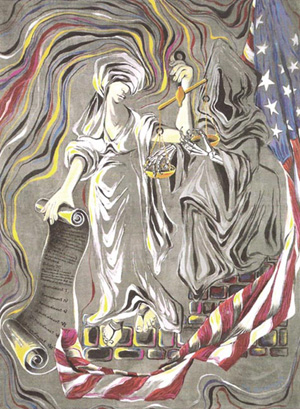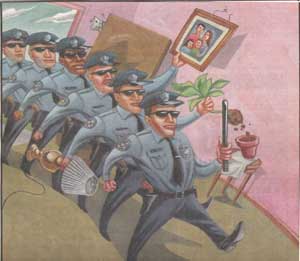
is a 501(c)(3) charitable organization. Donations are tax deductible.
20 Sunnyside Suite A-419, Mill Valley, CA 94941
 |
| Forfeiture Endangers
American Rights Foundation is a 501(c)(3) charitable organization. Donations are tax deductible. 20 Sunnyside Suite A-419, Mill Valley, CA 94941 |
ForfeitureEndangers
|
"Civil asset forfeiture
has allowed police to view all of America as some giant national
K-Mart, where prices are not just lower, but non-existent — a sort of
law enforcement 'pick-and-don't-pay.'"
—U.S. Representative Henry Hyde,
Forfeiting Our Property Rights: Is Your Property Safe from Seizure? "Findings suggest asset
forfeiture is a dysfunctional policy. Forfeiture programs, while
serving to generate income, prompt drug enforcement to serve functions
that are inherently contradictory and often at odds with the demands of
justice."
—Mitchell
Miller & Lance H. Selva,
Drug Enforcement's Double Edged Sword: An Assessment of Asset Forfeiture Programs (Twelve
month
empirical
examination of the implementation
of laws from within the forfeiture program) |
|---|
Why do we FEAR asset forfeiture?Incredible as it sounds, civil asset forfeiture laws allow the government to seize property without charging anyone with a crime. Until FEAR achieved the nation's first major federal forfeiture law reform at the turn of the millenium, the government was allowed to keep whatever property it seized without ever having to prove a case. Seized property was presumed guilty and could be forfeited based upon mere hearsay—even a tip supplied by by an informant who stood to gain up to 25% of the forfeited assets. Owners were forced into the untenable situation of trying to prove a negative—that something never happened, even though no proof of any illegal act had been offered at trial.Newspapers and television stories across the nation documented hundreds of cases of innocent citizens wrongfully deprived of their homes, businesses and livlihoods. Eighty percent of property forfeited to the US during the previous decade was seized from owners who were never even charged with a crime! Over $7 billion has been forfeited to the federal government since 1985. Until the advent of FEAR law enforcement officials promoting expanded forfeiture laws comprised the overwhelming majority of lobbyists at hearings on forfeiture litigation. Meanwhile, prosecutors complained that police were less available to investigate crimes that did not involve forfeiture. Over 200 federal forfeiture laws are attached to non-drug related crimes. Even a false statement on a loan application can trigger forfeiture. Physicians are subject to forfeiture of their entire assets based on a clerical errors in medicare billing. The government even tried to forfeit a farmer's tractor for allegedly running over an endangered rat. The federal governmen In April, 2000, FEAR achieved the nation's first major federal forfeiture law reform, the Civil Asset Forfeiture Reform Act of 2000 (CAFRA). The sponsor of the act, Rep. Henry Hyde, thanked FEAR in the April 11, 2000, congressional record "for their long and dedicated work on behalf of forfeiture reform." Though the final compromised version was stripped of many of the reforms for which we lobbied, for the first time since civil asset forfeiture laws were passed, under CAFRA the government:
Further changes are still
urgently needed at both federal and state levels. Many
innocent owners still face the untenable situation of having to prove a
negative—that their property was not involved in a crime, or that they
had no knowledge of criminal activity. Most owners of seized property
still lack the financial resources to even bring their cases to court.
A final hour amendment to CAFRA won by the Dept. of Justice allows
appointed counsel only for
property owners who have court appointed attorneys in related criminal
charges, and for some owners of seized homes. Innocent owners who are never
charged with a crime still must prove their innocence in complex
proceedings, where many cases are lost before even coming to trial.
Most
forfeiture
cases are never contested, in part because contesting
the proceedings can cost more than the value of what's been
confiscated. "The average vehicle siezed is worth about $4,000,"
states FEAR president Brenda Grantland, Esq. "To defend a case,
especially when you're out of state, they've pretty much made it cost
prohibitive." Under civil asset forfeiture laws, the simple
possessoin of cash, with no drugs or other contraband, can be
considered evidence of criminal activity. |

|
|||||
|
Civil asset forfeiture laws pervert law enforcement priorities at your expense. "Even if you're a
law-abiding citizen who's never been convicted of a crime, local police
are allowed to confiscate your property and money and keep up to 80
percent of it for themselves, with the legal stipulation that this
windfall be spent only on programs likely to result in additional
confiscations where the police can keep up to 80 percent of the booty
for themselves," wrote Jennifer Abel in an October, 2007, article
published by the Hartford
Advocate. "Because that would just
give us a bunch of dope and the hassle of having to book him
(the suspect). We've got all the dope we need in the property
room, just stick to rounding up cases with big money and stay away
from warrants."
In one case an
agency instructed the researcher to observe the suspect's
daily transactions reselling a large shipment of cocaine so
that
officers
could postpone making the bust until after the majority of the
drug shipment was converted to cash. This case was only one of many in
which the goal was profit rather than reducing the
supply
of
drugs reaching the street. "A conflict of interest between effective
crime control and creative fiscal management will persist so long as
law enforcement agencies remain dependent on civil asset forfeiture." —John
L.
Worrall,
Department of Criminal Justice, California State
University, San Bernardino, Addicted
to the drug war: The role of civil asset
forfeiture as a budgetary necessity in contemporary law enforcement,
Journal
of
Criminal
Justice Volume 29, Issue 3, May-June 2001, Pages
171-187.
Now is the time to:
See What's New at FEAR |

|
| FEAR's "Gideon
Project" — to increase the availability of counsel
for forfeiture victims
Victims of federal forfeiture cases whose
homes were seized are eligible for court appointed counsel under the
Civil Asset Forfeiture Act of 2000 (CAFRA). Civil
forfeiture victims frequently contact FEAR complaining that they can't
afford to hire counsel because all of their assets were seized.
For those financially unable to hire forfeiture counsel, CAFRA requires
the court to appoint counsel when the claimant's primary residence is
seized. Where the claimant has a court appointed attorney in a
related federal criminal case, CAFRA permits the court to
appoint that attorney for any other type of civil forfeiture case as
well. Unfortunately, many federal judges apparently do not know about these provisions. In one case, the pro se claimant and his wife actually asked for counsel to be appointed to defend their residence and the judge denied it. He was forced to defend against summary judgment pro se, while incarcerated -- and he lost. Then he contacted FEAR. He followed our advice and argued that the summary judgment ruling was void because he and his wife had been denied their statutory right to counsel under CAFRA. The judge vacated the ruling, and appointed counsel. FEAR has been trying to determine the extent to which CAFRA's Right to Counsel provisions are being implemented. It appears from our preliminary research that court appointments are rare. FEAR is seeking funding to embark on a project to address this problem. We have named it "The Gideon Project" (after Gideon v. Wainwright, the Supreme Court case that established the constitutional right to counsel in criminal cases). The plan includes three components:
Tax-deductible donations can be made online at the FEAR website, using Paypal, or by mailing checks to FEAR Foundation, 20 Sunnyside Suite A-419, Mill Valley, CA 94941. Write "Gideon project" in the memo line of your check to earmark the funds for this project. |